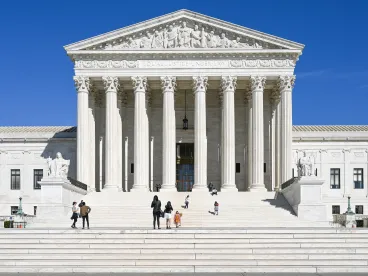Today, in an opinion that purports to be narrow but will have sweeping implications, the Supreme Court ruled that Andy Warhol’s well-known “Orange Prince” illustration is not a transformative fair use of Lynn Goldsmith’s photograph of Prince.[1] Discounting the new expression and meaning that Warhol added to the photograph through his famous silk-screening process, the Supreme Court majority suggested that Warhol’s contributions were “modest alterations”[2] and focused instead on the commercial use of the allegedly infringing work at issue. Because the Andy Warhol Foundation (“AWF”) and Goldsmith both licensed their respective works to magazines, Warhol’s Orange Prince was not transformative and AWF may be liable for copyright infringement. Now, to determine whether a work is transformative as opposed to an infringing derivative work, artists must question—potentially far in advance—whether the new work will share substantially the same commercial purpose as the original work. Rather than prognosticate, artists may be well-served by securing a license to the original work just in case.
Writing in dissent, Justice Elena Kagan called Warhol “the avatar of transformative copying”—an apt moniker.[3] His illustrations of soup cans, soap-pad boxes, Chairman Mao, Liz Taylor, Marilyn Monroe, and—at issue here—Prince all stem from photographs of those subjects. Warhol altered (dare we say, “transformed”) these images using a laborious and complicated silk-screening process that Warhol perfected to create these works that appear in every major art-history textbook. Are his Prince works different than the original photograph? All those offering testimony in this case answered yes. But to the majority, “[b]oth are portraits of Prince used in magazines to illustrate stories about Prince”—and that’s what matters.[4] Unlike Warhol’s soup cans, which are transformative because they illustrate consumerism and the soup cans themselves advertised soup, Orange Prince was used in the same way as the base photograph, in a magazine article on Prince. And that makes it derivative (and potentially infringing), not transformative.[5]
In reaching its decision, the majority balanced the original copyright holder’s exclusive right to create derivative works (i.e., “recast, transformed, or adapted works”) with the fair-use doctrine, which “permits courts to avoid rigid application of the copyright statute, when, on occasion, it would stifle the very creativity which that law is designed to foster.”[6] So, to preserve a copyright owner’s right to create derivative works, “the degree of transformation required to make ‘transformative’ [and thus fair] use of an original must go beyond that required to qualify as a derivative.”[7] Accordingly, “[a] use that shares the purpose of a copyrighted work … is more likely to provide the public with a substantial substitute for the matter protected by the copyright owner’s interests in the original work or derivatives of it.”[8] In other words, art that supersedes other art in substance and purpose of use is not “transformative” fair use.
As to this central point, perhaps there is some agreement among the Court. But the majority and the dissent disagreed most vociferously on whether Warhol’s Orange Prince indeed supersedes the object of that work, Goldsmith’s photo. To answer this question, the majority focused on the similar commercial nature of both Goldsmith’s photo and Warhol’s illustration, while the dissent aims at the artistic differences between the works themselves, writing that the works “could not have been more different”:
All I can say is that it’s a good thing the majority isn’t in the magazine business…. [An editor] would be drawn aesthetically to one [work], or instead to the other. You would want to convey the message of one, or instead of the other. The point here is not that one is better and the other is worse. The point is that they are fundamentally different. You would see them not as substitutes, but as divergent ways to (in the majority’s mantra) illustrate a magazine about Prince with a portrait of Prince. Or else you (like the majority) would not have much of a future in magazine publishing.[9]
But it is the majority decision that governs, and as such, artists and copyright owners must now keep in the forefront of their minds the potential future uses of a work (even decades later) when evaluating whether the new creation is fair use or unlawfully derivative. Where will this lead? Likely to more licensing. And if this decision happens to spur the monetization of art to the benefit of creators, perhaps it achieves the goal of the Copyright Act, “to encourage creativity.”
FOOTNOTES
[1] See Andy Warhol Foundation for the Visual Arts, Inc. v. Goldsmith, 598 U.S. ___ (2023). Read the decision here.
[2] Op. at 33.
[3] Dissent at 4.
[4] Op. at 22.
[5] Op. at 26-27.
[6] Stewart v. Abend, 495 U.S. 207, 236 (1990).
[7] Op. at 16.
[8] Op. at 19 (cleaned up).
[9] Dissent at 10 (cleaned up).




 />i
/>i


